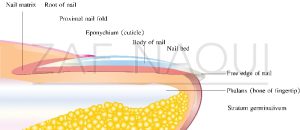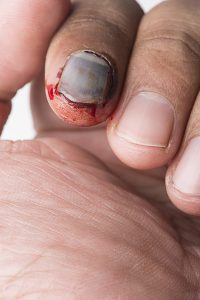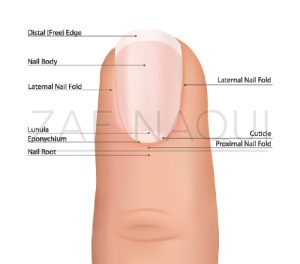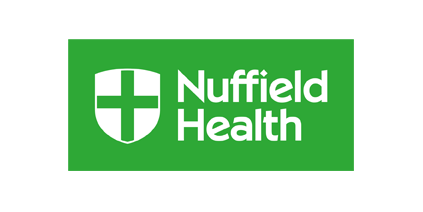Nail Bed Injury
What is it?
The nail bed is the fleshy part of the fingertip upon which the nail (technically referred to as the nail plate) sits. New nail grows from a special part of the nail bed which is called the germinal matrix. The rest of the nail bed supports and holds the nail down on the fingertip, this part is called the sterile matrix.
Who gets it and what causes it?
Nail bed injuries are common in both adults and children. Classically they are caused by trapping the finger in the door, but also occur as a result of a crush injury.

What are the signs and symptoms?
Patients will experience pain, swelling and bruising at the fingertip. Blood can collect under the nail and this can be especially painful.
What tests will I need?
The first step is to undergo a consultation, involving a medical history and clinical examination. Mr Naqui may organise further tests such as an x-ray. An x-ray can reveal if there has been an associated fracture of the bone underneath the nail bed.
What is the treatment?
Primary treatment usually includes checking for tetanus cover, cleaning the injury and antibiotics.
If the nail bed is injured significantly, this may result in disturbed and problematic nail growth which can lead to pain and difficulty using the finger. In this situation, the nail bed may benefit from surgical repair. Mr. Naqui will discuss the options with you.
What does the surgical treatment involve?
Surgery is performed under a local anaesthetic, numbing the finger for a short period of time. The nail bed is repaired using very fine stitches, placed whilst using magnified glasses. You will be able to go home the same morning or afternoon

What happens after the surgery?
Taking simple painkillers such as paracetamol regularly for the first 2 days after the operation will help to relieve any post-operative pain.
Mr. Naqui and the hand therapist will then provide you with a specially adapted splint and specific exercises to perform to maintain normal movements in the rest of the hand.
Stitches are usually removed after 10 days.
When I can return to normal activity?
Following nail bed healing, you will be given formal exercises to regain full flexibility of the fingertip.
Mr. Naqui will discuss with you regarding return to sports depending upon your particular sport – as a protective splint could be worn to help you get back to sport earlier. Driving can safely be resumed at around 2 weeks. Return to work is dependent on the nature of you work but usually expected within 2 weeks if it is non-manual work. You can discuss this with Mr Naqui at your consultation.
What are the complications of surgery?
The main potential complications that will be discussed with your prior to gaining consent for surgery include nail deformity, pain, swelling, infection, stiffness, scarring and numbness.
Pain and swelling are common following surgery, these should settle after a few days with simple painkillers. Infection is rare. Stiffness at the joint should resolve if you follow the exercise programme as advised by Mr Naqui and the hand therapist following surgery.
In a proportion of patients nail growth may still be disturbed due to the severity of the original injury. If this were to happen then there are further non-surgical and surgical options, which you can discuss with Mr Naqui.






